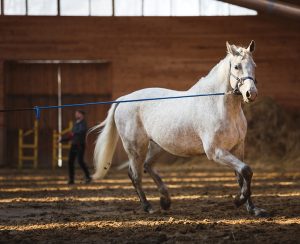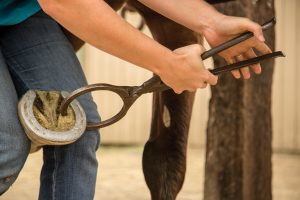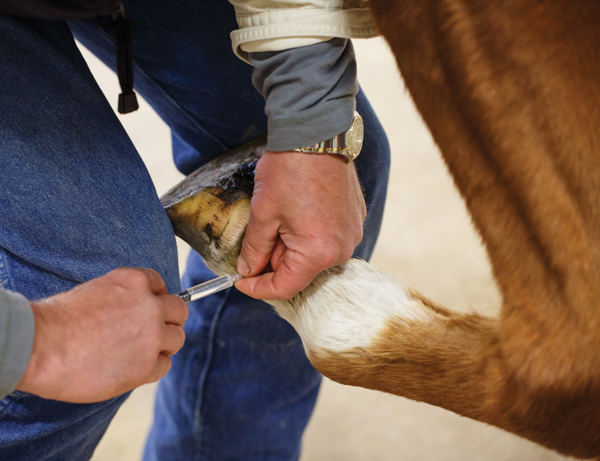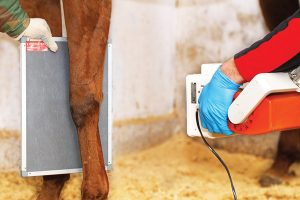
You or someone you know has probably had a horse come up lame for a reason that’s not immediately obvious. He doesn’t have an obvious wound or a swelling that you can see from across the barn aisle, yet is limping nonetheless. It’s perplexing. Horses are a significant investment of time, money and emotion. You’d really like to know what’s wrong. However, you most likely also have a few questions rolling around in your mind about diagnosing a mystery lameness:
◆ Even if you do write a blank check, how likely is it that you will come up with an answer?
◆ Even if you do come up with an answer, will the answer make any difference in your treatment?

The standard for lameness diagnosis and treatment has been to try to find out exactly what the problem is and then try to “fix” it. If you know the exact cause, you can often come up with a treatment plan that is most likely to result in a horse that is lameness-free (and as soon as possible).
But it’s more than that. Knowing “exactly” what the problem is a powerful and important psychological motivator. Knowing what’s going on with a horse gives a sense of control to an emotionally unsettling situation. The horse has a problem, but with knowledge, veterinarians and owners become empowered to do something.
Trying to define the precise reason for a horse’s lameness is a good goal, but
unfortunately, it’s one that’s not always possible. In spite of careful observations and extensive diagnostic work, and even with the advances in diagnostics and therapeutics that have occurred over the past several decades— ultrasound, MRI, CT scan, scintigraphy, et cetera—there are still lame horses that defy an accurate diagnosis.
There are also those that in spite of a precise diagnosis don’t respond well to treatment. What’s an owner to do? We’ll break down a lameness exam and go step-by-step through the procedure and the costs.
Cost LeveL 1: The Physical Exam
To diagnose a mystery lameness, the horse is initially examined from a distance for things like how he holds his leg(s), abnormal bumps or swellings, his attitude, and other hints that might indicate the source of the problem.
Next, the horse is usually examined up close. The leg is poked, bent, hoof-tested, prodded, moved, et cetera, in a variety of ways to see if there’s a response that might indicate pain (with emphasis on the “might”).
Many times—probably more than 50 percent of the time—careful examination is all that’s needed in order to determine the source of the lameness, or at least to give a good idea if there’s a serious problem.

A good physical exam is important, but it can be misleading, too. Sometimes, a horse with an obvious lameness does not respond in any meaningful way to all of the poking, prodding, and manipulation. On the other hand, some horses respond to just about any sort of poking, prodding, and manipulation, thereby rendering such well-intentioned annoyance (to the horse) somewhat meaningless.
For example, if a horse reacts to having the base of his neck pinched, it’s possible that could indicate some neck or shoulder soreness. It could also mean that the horse doesn’t like to have his neck pinched.
Such things are important to keep in mind when diagnosing a mystery lameness, especially when you’re confronted with unique diagnoses based on a response to a horse being poked at some special “point.” One of the difficulties in interpreting the response of horses to various stimuli is that they’re subjective. If your horse is doing fine and someone tells you that there’s a problem based on responses to such stimuli, don’t be too quick to think that there’s a hidden problem.
The Horse in Motion
After the physical exam, the horse is usually examined in motion. In the field, this can be done in hand, at the longe (on a line or free), or under saddle, and after various stress tests (e.g., flexion tests).
Here, too, there can be a lot of room for error. For example, riders can alter the way horses move, and flexion tests are notorious for being non-specific—that is, they don’t pinpoint lameness—as well as causing a lot of false positives. Some horses may trot “off” after flexion because they don’t like having their legs bent up, not because of any real problem.
Even with the limitations, watching the horse move is an integral part of a lameness exam.

Cost LeveL 2: Local Anesthetic Blocks
It’s often a good idea to confirm that the reactions noted during the physical examination are actually associated with the lameness. Alternatively, if the physical examination is relatively non-productive, that is, no sore spots or swellings are found, but the horse keeps limping anyway, local anesthetic “blocks” are usually the next step.
The idea with nerve blocks is disarmingly simple. The horse is limping because something hurts. You make the part that hurts go numb and, voilà, the horse stops limping.
Nerve blocks are a very important part of a lameness exam. However, over the past couple of decades, veterinarians have become aware of the fact that nerve blocks are not as precise as was previously assumed. That may mean a veterinarian may be “blocking” more anatomical sites than he or she thought, and that the lameness has not really been specifically pinpointed to a particular location. On the other hand, some spots are so big, or so difficult to reach, that they can be very difficult to block.
Regardless, after anesthetic blocks, in most horses you can eventually make the horse stop limping, and you can begin to focus on a specific area as the source of the lameness problem.
Cost LeveL 3 (and Higher): Additional Diagnostic Tests
Unfortunately, even if you can make a horse lameness-free with an anesthetic block, you still may not know exactly what’s wrong. As such, there may be a desire to look deeper, that is, to go on with additional diagnostic tests.

Depending on what is used, cost can be in the thousands. Photo by Osetrik/Shutterstock
That’s when veterinarians may suggest diagnostic tools such as MRI, ultrasound, radiographs (X-ray), scintigraphy, or CT scan, to get even more information. Of course, all of this diagnostic curiosity, while perhaps ideal from a diagnostic standpoint, can get really expensive.
For example, MRI, which can give a very detailed picture about what’s going on inside the area examined, can easily run $2,000 or more.
Diagnostic Costs vs. Benefits
When evaluating lameness, horse owners can rapidly run into a conflict between wanting to find out exactly what a horse’s problem is and wanting to be able to buy groceries next week. It may be great to know exactly what’s causing a
horse to limp, but at what cost?
Furthermore—and this is an important question to ask—even if you decide to pay for the test, is the knowledge gained likely to change the treatment?
Resetting the Bar
In my opinion, while knowing exactly what anatomical area is causing a horse’s lameness is a great goal, in some circumstances, it might be good for horse owners to think about resetting the diagnostic bar.
There is such a thing as “overdiagnosis,” that is, information that doesn’t really help in selecting a treatment or improving an outcome. Perhaps a more realistic and less expensive standard—especially when it comes to difficult “mystery” lameness cases—might be to try to find out if the horse’s problem is likely to be serious, and then go from there.
Lameness Treatment OptionsOnce your vet has come up with a diagnosis of the mystery lameness, there’s still the cost of treatment. assuming that you can find the cause of your horse’s lameness, there are usually many, many possible treatment options. From a scientific and biological point of view, these can range from the sublime, that is, treatments supported by good studies and data (otherwise known as “the ones that you should be inclined to use”), to the ridiculous (an extremely long list). If the cause of the lameness remains elusive, the list of treatment options and opinions is virtually endless, and virtually guaranteed to make any caring horse owner crazy—and poorer. Often forgotten is that when it comes to therapeutics, particularly with lameness, in most cases, the most important tool in the toolbox is time. Time does heal many wounds, and if you’ve had a good exam and determined that there’s not likely to be a serious problem, there’s nothing wrong with stepping back a bit to wait and see how things turn out instead of feeling the need to diagnose the mystery lameness. |
This article about diagnosing a mystery lameness originally appeared in the October 2019 issue of Horse Illustrated magazine. Click here to subscribe!






It is super easy to connect to the horse energetically and ask the body what it wrong. I have been doing this for decades with great accuracy. Just saying